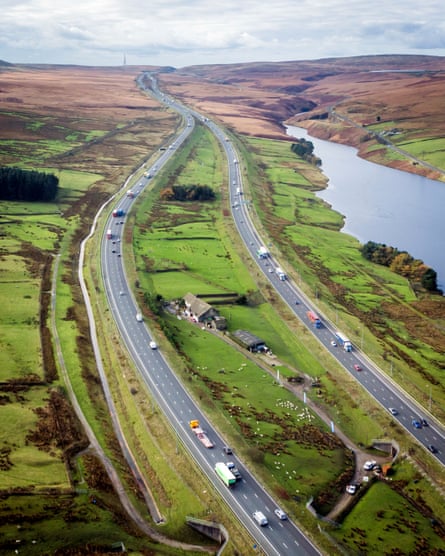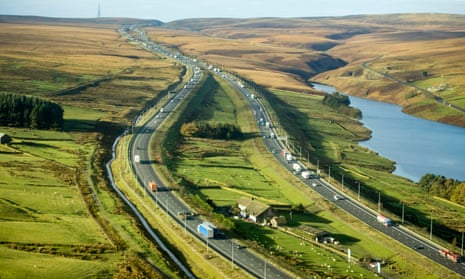It was seen for half a century as a proud testament to Yorkshire bloody mindedness: the farm in the middle of the M62, the house the planners had to build around when the owner refused to move.
The myth was somewhat debunked last year when a recently unearthed documentary revealed that a geological fault, rather than an awkward farmer, was the real reason for Stott Hall, which lies west of Huddersfield, in West Yorkshire, being left in that peculiar location.
The intrigue refuses to go away. But on Thursday the farm inched open its gates to give a fuller glimpse of life inside Stott Hall, as part of an initiative by Yorkshire Water to encourage the region’s farms to become climate friendly.
The farm, which has been owned by Yorkshire Water since 1989, is joining the Beyond Nature programme – a scheme designed to protect wildlife biodiversity, water quality and carbon storage, making farms in the region more sustainable. The Beyond Nature scheme here will mean restoring miles of peatland bog, which helps lock carbon dioxide in the land and mitigate the risks of global warming.
Yorkshire Water specialists will work to raise the water table of the moors, helping to minimise the flooding risk that has become a depressingly familiar fixture of life in the valleys surrounding Stott Hall.
Lisa Harrowsmith, a lead surveyor at Yorkshire Water, said that despite the Stott Hall’s unique position it was a classic upland farm with lots of biodiversity.

Paul Thorp, the current tenant, who has worked at Stott Hall since 1992 but lived there with his wife, Jill Falkingham-Thorp, since 2008, said: “Whenever you go anywhere and say where you live, everyone’s curious and wants to know all about it.”
Behind the farm’s triple-glazed windows, a distant hum is all that can be heard of the roaring traffic that sandwiches the 280-year-old farmhouse. Trees have been planted strategically outside the kitchen window to obscure the view of the passing Eddie Stobart lorries and, thanks to mobile phones, the farmers no longer get woken up in the middle of the night by drivers asking to use their landline.
Outside, it is almost a picture of countryside bliss. The couple’s four-year-old son, John, plays in the field as the family sheepdog, Sweep, herds up the bleating sheep. A child’s toy tractor and lorry sit outside the front door. The farm is so cut off that the nearest Co-op is about 10 miles away, explained Thorp, “so if you want a pot of tea you go sparing with the milk”.
But the family will now be diversifying their work by exploring ways of educating youngsters about the importance of looking after the environment. Jill said: “If you don’t pass all your knowledge on to the future generation, what’s the point? We’re not here forever. We should try do our absolute best while we’re here. You ask any kid in school where their beef is from and they will say Tesco or Morrisons. Nobody seems to know about their food.”
The family manages 900 breeding ewes and 20 suckler cows on its 348 hectares of moorland on the highest and often most nerve jangling stretch of the motorway.

Thorp doesn’t think much to the roaring motorway that carries 100,000 motorists a day past his front room. “I had to go into Bradford on Tuesday morning and I just thought ‘god if this is what people have to do every morning I’ll stop at top of hill’.”
Their friends and family live half an hour away in Holmfirth, below Huddersfield, so life beside a motorway can get lonely, said Jill. “You’ve all these people flying past but you don’t know anybody,” she said. “You get the odd person that you recognise and they peep and you wave. You don’t get people just calling in for a brew, or just dropping in because it just seems to take so long to get here. You don’t have passing people coming down your lane.”
One of the quirks of living at Stott Hall is that so many others on Facebook claim to as well, said Thorp, who worked as a shepherd for the previous owner, Ken Wild, whose refusal to move became the stuff of legend for the millions driving past each year.
The couple are at a loss to explain why that myth prevails. “If enough people say it, enough people believe it,” Thorp said. “If they read it on internet then that’s it, it’s truth, in’t it. Except, it’s not true!”











Comments (…)
Sign in or create your Guardian account to join the discussion